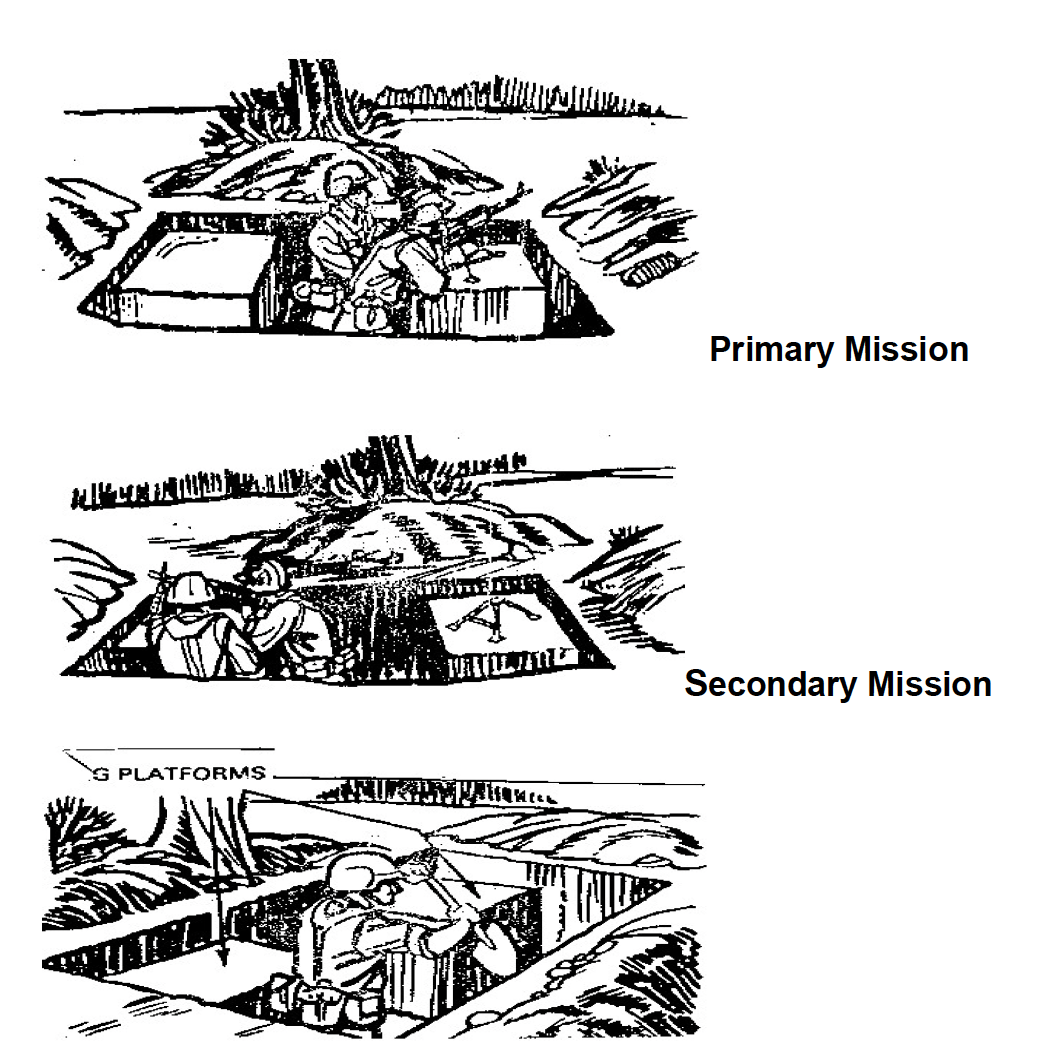Machine guns in the Defense
1/41
There's no tags or description
Looks like no tags are added yet.
Name | Mastery | Learn | Test | Matching | Spaced |
|---|
No study sessions yet.
42 Terms
3 different roles of MGs in Defense
Long range fires
Close defensive fires
Final protective fires
Long range fires are
delivered against enemy units for the purpose of interdicting and disrupting those units before they are deployed in the attack
employed to harass enemy in their AA
preempt enemy’s attack
disrupt enemy’s formations
interrupt timing and sequencing
long range fires can be delivered from
full defilade positions
max range of weapon system
mobile positions forward of main defense
close defensive fires are
delivered against targets that present an immediate threat to the defense
what fires are the main effort of the defense?
close defensive fires
final protective fires do what
provide an immediately available prearranged barrier of fire that is designed to impede enemy movement across defensive lines or areas
For machine guns, their FPF can be one of two things
final protective line (FPL)
Principal direction of fire (PDF)
When are final protective fires employed?
the close defensive fires have failed
Who authorizes FPF?
can only be authorized by the immediate commander or higher authority
FPL is a
predetermined line of grazing fire designed to stop an enemy assault
FPL is fired where and attempts to produce what
across the frontage of a defensive line and is optimally as close and as parallel to the defensive lines as possible to produce FLANKING ENFILADE FIRE
For FPL and PDF, the assigned weapon will have an assigned __ to employ what
left and right lateral limit to employ close defensive fires and potentially long range fires
T or F – if the FPL weapon is not being employed, it can be oriented in any direction
F, it is laid on the FPL
The PDF is
a predetermined line of machine gun fire that covers the most dangerous avenue of approach to a defensive position with either plunging or grazing fire
The PDF attempts to produce what
frontal enfilade fire
The PDF will always be set on what on the traversing bar and why?
set on zero to split the sector of fire
Weapon system considerations for the M240B
can be rapidly moved to alternate or supplementary position
assigned 2 sectors using bipod and tripod
can be brought on contact or ambush patrol
the 50 caliber HMG is ideally placed where?
on an avenue of approach that will canalize the enemy within its beaten zone
T or F - the MK19 can achieve grazing fires
F, based on the ammunition
Positions of machine guns should be based on what
enemy and terrain analysis
T or F – machine guns can be placed on the extreme flanks of the platoon
F
Primary position is
the position from which the gun will fire its primary sector of fire
The alternate position is
the secondary position from which the gun will fire its primary sector of fire
The supplemental position is
another separate prepared position from which gthe gun fires a secondary or alternate sector of fire
Types of machine gun positions
T shaped fighting position
Horse Shoe fighting position
Two hole fighting position
Which MG position is the most preferred position to employ?
the T shaped fighting position
The T shaped fighting position can do what and how is this done
provide both primary and secondary sectors of fire
Tripod is on primary sector and bipod for secondary fire

For T shaped fighting position, how deep should it be?
armpit deep
The Horse shoe fighting position description
Open end of horseshoe toward enemy for 180 degree traverse across frontage

Comparison between horse shoe and t shaped fighting positions
Horse shoe provides less frontal cover but more protection from idf than t shaped
The horse shoe is more ideal for what weapon system?
heavy machine guns
Two hole fighting position description
Two one man fighting holes at 90 degree angles
Excellent protection for gunners
Limited traverse of gun
When switching form primary to alternate sectors of fire, gunner and a-gunner switch roles

A range card is
a diagram drawn to record the firing data and mission of the machine gun position
also serves as a document to assist in defensive fire planning
how many range cards are created and who are they for?
2 range cards
1 for the gunner, the other for the squad leader
The key element of creating a range card is to
walk the terrain we are about to document
When is a range card built?
after the commander and MG unit leader have decided on positions and mission
Steps for creating range card
Gunner lays behind gun, sets sights on limit of grazing fire, then aiming point along FPL/FPF
Team leader walks along FPL or PDF
When gunner loses sight of team leader, they yell “mark”. Record the distance
Defensive fire control measures
Trigger lines
Target precedence
Engagement criteria
Target reference points
Displacement criteria
Ammo allocation
T or F – Minimum Safe lines (MSLs) are used in static defensive positions
F, only for offensive operations or mobile defense or retrograde possibly
When should the defensive fire control measures be addressed? When should they be explicitly stated?
addressed: during the scheme of maneuver, stated: coordinating instructions
Tactical tasks for MGs
Suppress
Fix
Neutralize
Trigger lines should include
prescribed engagement criteria and target precedence for each trigger line